|
Small Wonders: Victorian Microscope Slides
| By Howard Lynk
Posted February 2015
|
 |
Jewels! Brilliant, sparkling jewels of every imaginable shape, and like grains of sand on the beach or stars in the sky, beyond count. Fortunately, one doesn’t have to visit the grand palaces and museums of Europe to view such incredible wonders. These little gems can be found all around us! They are known as diatoms and live nearly everywhere there is, or has been, water.
Diatoms are microscopic unicellular forms of algae. The little “jewels” we find, known as frustules, are actually very small, clear silica shells (natural glass!) that each individual diatom creates while alive. These beautiful frustules remain even after the diatom dies. Different species of diatoms each produce their own unique and intricate geometrically shaped frustule. While some common diatom species are distributed worldwide, others are very rare and found in only a few, or even a single, geographic location. Diatoms inhabit both marine (salt water) and fresh water environments. The obvious places to find live diatoms include bodies of water such as the oceans and seas, bays, rivers, lakes, ponds, streams and drainage ditches. They can also frequently be found living in architectural fountains, birdbaths, rain gutters and even in damp soils.
|
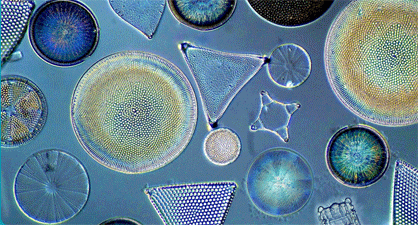
|
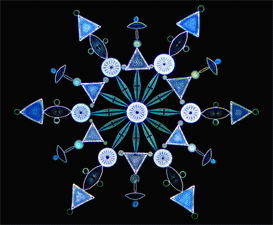
|
|
Close-up detail of mounted diatoms with regular markings and perforations, useful for testing microscope lens resolution.
|
Beautiful "snowflake" arrangement
of diatoms
by J. Moller, c. 1880s.
|
Accumulations of these microscopic jewels, the remains of countless generations of diatoms, can always be found and collected from the bottom material in the same environments as the living specimens. With careful observation, they can also be discovered in practically any type of soil material. Certain geologic formations contain nearly pure deposits of diatoms, sometimes many feet thick, where large bodies of water once existed. Recent scientific research suggests that diatoms, along with other species of algae, have produced a significant portion of the oxygen in our atmosphere through the ongoing process of photosynthesis.
Fossil diatoms have been found dating from at least the early Jurassic Period, 185 million years ago; although, there is some evidence they may have lived on the Earth much longer. The study of recent and fossil diatoms in relation to their geographic distribution has become an important tool in understanding our natural environment, both past and present.
It wasn’t always that way. Little was known of them until the beginning of the second quarter of the 19th century when microscope lenses were finally developed to a point where diatom frustules could be seen with some clarity. By the latter 1830s, there were already individuals (often clergymen) especially interested in a study of the diatoms: finding, identifying, naming, classifying, and importantly, making permanent mountings of them. It was soon noticed, as well, that the regularly spaced, minute markings and perforations visible on certain species of diatoms could be used as a gauge or measurement of lens quality and resolution. Slides made up using these diatoms were known as test slides and were used to compare and further improve the quality of microscope lenses.
All of the earliest diatom mounts were “strews,” which are slide preparations of randomly placed diatom material, usually from a specific geographic location. The first known reference to selection of a particular diatom for mounting was in 1849. By the mid 1850s, we begin to see diatom preparations where individually selected specimens are mounted, either singly or loosely arranged in small groups or lines. As the study and appreciation of natural history became an increasingly popular pastime in the second half of the 19th century, there was a corresponding growth in the number of commercial slide makers offering readymade preparations of every conceivable type. Most of these professional mounters also prepared and sold slides of selected diatom species, as well as simple arrangements. This trend culminated with a small number of very talented and artistic slide makers becoming recognized as consummate diatom specialists. Their output ranged from amazing works of mainly scientific value, such as miniature grids of named diatom species, to purely artistic efforts, often with hundreds of diatoms arranged into complex geometric patterns or as realistic images.
|
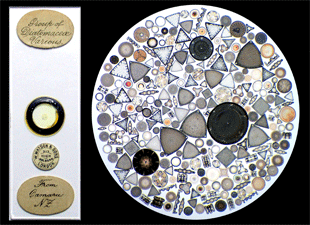
|
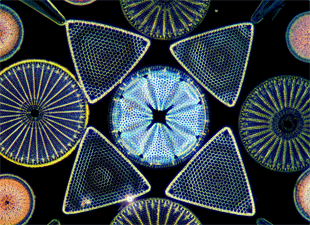
|
|
200+ diatoms from New Zealand selected and placed in a
circular arrangement by Watson & Sons, c. 1880s-1890s.
|
Close-up detail of diatoms in an arrangement; different colors are produced by diffraction of light passing through the clear, glass-like diatom frustules.
|
Diatoms were also frequently incorporated in mixed arrangements that included other minute natural items such as butterfly scales and sponge spicules. These artistic arrangements using diatoms, known as salon or exhibition slides, were primarily made in the latter part of the 19th century. All are highly sought after today by collectors of antique microscope slides.
Creation of such miniature wonders was by no means a trivial task! Many hours of painstaking labor were involved in making each one. The naturally occurring diatoms, collected from many different locations, first had to be thoroughly cleaned of organic material or debris. Next, working under a microscope, various specimens would be selected and isolated for later use, based on shape and size. Originally, this was done using fine boar bristles or cat’s whiskers to manipulate each diatom. Finally, the “canvas,” usually a clean 1 x 3-inch glass slide, was put in position and the actual arrangement begun.
The first individual diatom was selected and transferred to this clean slide, being carefully manipulated into position, ever mindful of the artistic design. This process was carefully repeated many times until the desired arrangement was complete. Finally, the diatom arrangement would be made permanent by sealing with Canada balsam and a thin cover glass.
The mounters who specialized in these kinds of slides eventually developed and used microscopes, incorporating an airtight box and more refined tools for manipulation. These allowed the fragile arrangements to be created in an enclosed environment where a passing breeze, ever-present dust, or the resident cat could not ruin the work in progress.
The collection, mounting and study of diatoms were just one chapter in a much larger story that is now seen as nearly synonymous with the Victorian Era: the popular fascination with natural history, the natural world and collections of specimens. While this energetic interest and activity originated and was primarily centered in England, it flourished in the United States and Continental Europe as well.
|
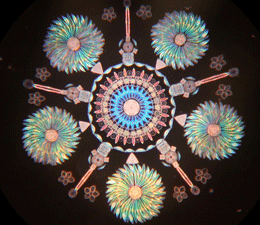
|
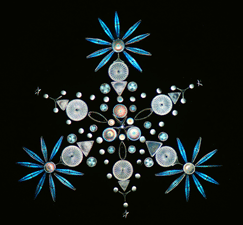
|
|
A diatom by Klaus Kemp who continues to create
them and offers them for sale on his website.
(Photo: Klaus Kemp, www.diatoms.co.uk.)
|
Geometric arrangement of diatoms and sponge
spicules by E. Thum, c. 1880s-1890s.
|
The primary tool that made this popular enthusiasm possible was the microscope. Within a 20-year period, the microscope went from being a very expensive handmade instrument in the hands of only a relatively few wealthy individuals to a widely available, mass-produced instrument, affordable by practically anyone. Microscopy became a popular pastime for individuals of all social classes. Trips to the shore or walks in the countryside were opportunities for collecting specimens for later mounting and study. It wasn’t unusual for even laborers in the working classes to know the Latin names and habits of the insects, plants and animals living within their surrounding area.
The prized possession in many homes was a well-used microscope and a collection of prepared specimens, known as a “cabinet of curiosities.” The microscope was not viewed just as a tool for educational and scientific purpose but was actively used for entertainment and amusement as well.
While both encouraging and benefiting from this burgeoning, popular interest in science, numerous retail opticians shops supplied the growing amateur market, providing microscopes, mounting supplies and prepared microscope slides of every description. Starting in the 1830s, a few talented entrepreneurs began making slides for resale through these shops, eventually developing name recognition and becoming the first professional slide makers. Anyone even slightly familiar with antique microscope slides will probably recognize the names of C.M. Topping, J.T. Norman or E. Wheeler. They developed the skills and raw material sources necessary to create and offer literally thousands of different types of specimens of interest. An absolutely amazing variety of natural items from all over the world were procured and prepared as microscope slides.
As time went on, added to these natural objects were slides bearing miniature photographs, microengravings of religious texts or popular maxims, and other subjects prepared purely for entertainment value. It is difficult to overstate the extent to which the naturalist movement permeated the life and times of Victorian England.
However, after nearly 80 years, by the early 20th century, the Victorian Era fascination with natural history and “parlor microscopy” as popular entertainment was coming to an end. As interest waned and attention moved elsewhere, many of these incredible preparations, likely including many beautiful arranged diatom slides, were relegated first to the closet, then the attic or basement, and eventually the trash pile. Nowadays, most people don’t have any idea that these little works of art ever existed!
Thankfully, the fairly recent growth of interest in collecting antique microscope slides of all kinds has encouraged the preservation of surviving examples. In regard to diatom slides in particular, there has remained a small but consistent interest in their collection and study over the years, primarily by the academic and scientific communities and to a lesser degree, by amateurs. Whatever one’s introduction, they can’t help but be appreciated by anyone who sees them, if only for their incredible variety and beauty!
During the last decade or two, there has been a steadily growing interest in the field of antique slide collecting. A large community of knowledgeable collectors has developed worldwide, including those with a special interest in antique diatom slides and the beautiful arranged examples in particular.
|
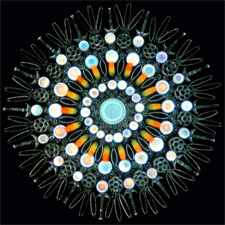
|
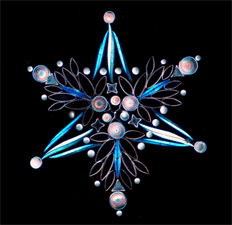
|
|
Diatoms, butterfly scales and spicules by
Watson & Sons, c. 1880s-1890s.
|
Geometric arrangement of diatoms
by E. Thum, c. 1880s-1890s.
|
The ongoing digitization of library resources and easy access via the Internet has made meaningful research accessible to all. These surviving artifacts from another age are beginning to be widely recognized and appreciated as the irreplaceable creations they are—amazing objects almost uniquely positioned at the intersection of history, science and the arts
I began collecting antique slides about 20 years ago when I found a few locally to add to some vintage examples I managed to hang onto from the 1950s. Growing up in that decade, I was fortunate to experience the very last fading rays of the amateur naturalist movement that had begun well over a century before. I spent many enjoyable times as a youngster exploring with my student microscope and chemistry set. With retirement on the not-so-distant horizon, I had decided perhaps microscopy might again be an interesting avocation to pursue.
They say timing is everything, and in my case, that proved to be true. The recent (at that time anyway) availability of the Internet and the worldwide web allowed the research and purchase of a good used microscope—the very same model I would have given practically anything to own in 1960! That purchase led fairly quickly to online searches for additional prepared slides to look at. I soon discovered one could occasionally find and purchase beautiful old antique slides at quite reasonable cost. Collecting for my personal “Cabinet of Curiosities” had begun!
As time has passed, the available online resources have grown substantially. In addition to the search engines, there are now many interest groups dedicated to amateur microscopy and websites about antique slides and collecting. My own informational website, “A Cabinet of Curiosities” can be found at www.victorianmicroscopeslides.com.
“Everyone’s favorite auction site” (eBay) is probably still the best source for purchase of antique slides with a wide and ever changing variety of offerings. An interesting collection can be started for very little cost; although, rare and desirable specimens or slides by particular makers are often worth significant sums. Prices run the gamut, from a dollar or less to thousands. Purely from an investment standpoint, good antique slides continue to appreciate in value.
As in all antique collecting, research and knowledge gained add to the interest but are also essential to wise collecting. Go slow and enjoy the journey!
--------------------------------
Howard Lynk has collected and researched Victorian Era microscope slides and their makers for many years. He presents the results of this ongoing research on his website, as well as in various other online and print publications. Inquiries concerning information or valuation of specific antique slides and collections are welcome.
|